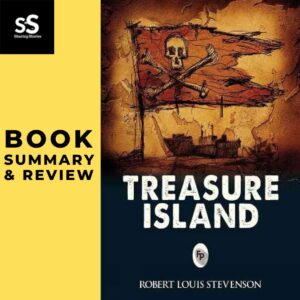Treasure island review
Treasure Island Review: A Classic Adventure Novel by Robert Louis Stevenson
- In Treasure Island, a timeless tale penned by Robert Louis Stevenson, readers are taken on a thrilling journey filled with pirates, treasure hunts, and high-seas adventures.
- Stevenson’s classic has stood the test of time, captivating audiences of all ages with its swashbuckling narrative and vivid imagery.

Table of Contents
Background of Treasure Island
- Treasure Island was published in the late 19th century and quickly became a literary treasure in the realm of adventure fiction.
- The novel is significant in the adventure fiction genre for its portrayal of pirates, hidden treasures, and the quintessential quest for fortune.
- Key themes and motifs in Treasure Island include greed, loyalty, and the allure of the unknown, making it a compelling read for fans of nautical adventure stories.
Plot Summary
- The story follows young protagonist Jim Hawkins as he embarks on a perilous sea voyage in search of buried treasure.
- Along the way, Jim encounters the cunning and charismatic pirate, Long John Silver, who becomes both ally and adversary in the quest for the fabled riches.
- Set against the backdrop of Treasure Island itself, the plot unfolds with suspense and intrigue, keeping readers on the edge of their seats.
Character Analysis
- Jim Hawkins: Stevenson masterfully crafts Jim’s character as the brave and resourceful hero of the story, showcasing his coming-of-age journey and resilience in the face of danger.
- Long John Silver: The enigmatic antagonist, Long John Silver, is a complex character whose cunning and charisma make him a memorable villain in pirate fiction.
- Other important characters, such as Captain Flint and Ben Gunn, also play crucial roles in shaping the narrative and adding depth to the storytelling.
Themes and Symbols
- Themes of greed, loyalty, and adventure are prevalent throughout the novel, highlighting the moral dilemmas faced by the characters.
- Symbols like the treasure map, the Black Spot, and the pirate flag serve as visual representations of key plot points and character motivations.
- Treasure Island imparts valuable moral lessons about friendship, trust, and the consequences of greed, resonating with readers on a deeper level.
Writing Style of Robert Louis Stevenson
- Stevenson’s writing style is characterized by its vivid imagery, descriptive language, and immersive storytelling.
- The author’s use of rich detail and evocative prose transports readers to the high seas, creating a sense of adventure and excitement throughout the narrative.
- Stevenson’s engaging writing style is a major contributing factor to the enduring popularity of Treasure Island among fans of classic literature.
Reception and Legacy of Treasure Island
- Treasure Island received critical acclaim upon its release and has since become a beloved classic in the literary world.
- The novel’s lasting impact on literature is evident through its influence on subsequent works in the adventure genre.
- Various adaptations and reimaginings of Treasure Island in popular culture further attest to its enduring legacy and continued relevance in today’s storytelling landscape.
Comparison to Other Works
- Treasure Island stands out among other adventure novels for its timeless story, compelling characters, and gripping plot.
- Stevenson’s expert blend of action, suspense, and moral complexity sets Treasure Island apart as a classic within the genre.
- The novel’s influence on later works of pirate fiction and adventure storytelling showcases its enduring legacy in literary history.
Treasure Island Review: Exploring the Depths of Adventure
Detailed Review of Treasure Island
Strengths of the Novel:
- Classic adventure novel: Treasure Island excels in delivering a thrilling narrative filled with high-seas adventures and hidden treasures, making it a timeless favorite among readers.
- Robert Louis Stevenson: The author’s masterful storytelling and vivid imagery breathe life into the story, captivating readers with his nautical charm.
Weaknesses of the Novel:
- While the plot is engaging, some readers may find the pacing slow, particularly in the build-up to the climax.
- The character development, while solid for the main characters, lacks depth for some secondary characters, leaving room for further exploration.
Evaluation:
- The plot intricacies and the clash between good and evil, represented by Jim Hawkins and Long John Silver, create a captivating narrative that keeps readers hooked throughout.
- Stevenson’s writing style, marked by descriptive language and vivid imagery, immerses readers in the world of pirates and treasure hunts, making the reader feel part of the adventure.
Comparison of Different Editions
Editions Comparison:
- Various editions of Treasure Island offer different cover designs and illustrations, appealing to diverse reader preferences and aesthetics.
- Some editions may include annotations or additional content, such as historical context or insights into Stevenson’s writing process, enriching the reading experience.
Recommended Edition:
- For readers seeking a classic edition that stays true to the original text, the illustrated editions with timeless artwork can enhance the reading experience.
- Those interested in delving deeper into the novel’s themes and motifs may prefer editions with annotated sections providing valuable insights and analysis.
Reader Reviews and Testimonials
Reader Insights:
- Readers praise “Treasure Island” for its captivating storyline and memorable characters, especially the cunning Long John Silver.
- Testimonials highlight the novel’s ability to transport readers to a world of adventure and piracy, sparking imagination and nostalgia for childhood tales.
Impact on Readers:
- The coming-of-age narrative of Jim Hawkins and the themes of loyalty, courage, and the lure of treasure resonate with audiences of all ages,
- Treasure Island evokes a sense of wonder and excitement, creating a lasting impression on readers who cherish its timeless storytelling, making it a treasured addition to literary collections.
Adaptations and Spin-offs
Adaptations Overview:
- Various adaptations of Treasure Island, ranging from movie adaptations to stage plays, have reimagined the timeless tale for modern audiences.
- These adaptations explore different facets of the story, bringing new perspectives and interpretations to the classic narrative.
Comparison to the Original:
- While adaptations may take creative liberties, they often stay true to the core elements of the novel, such as the themes of adventure and camaraderie, keeping the spirit of Treasure Island alive.
- Comparing these adaptations to the original novel allows readers to appreciate the timelessness and universality of the story, showcasing its enduring appeal across different mediums
Frequently Asked Questions About Treasure Island Review:
What is the main theme of Treasure Island by Robert Louis Stevenson?
The main themes of Treasure Island include adventure, greed, loyalty, and the quest for treasure amidst a backdrop of pirates and high-seas escapades.
Who are the main characters in Treasure Island?
The main characters in the novel are Jim Hawkins, Long John Silver, Captain Flint, and other pirates who play pivotal roles in the thrilling narrative.
How does Robert Louis Stevenson’s writing style contribute to the appeal of Treasure Island?
Stevenson’s use of vivid imagery, descriptive language, and engaging narrative style creates an immersive reading experience that transports readers into the world of pirates and buried treasure.
What is the significance of the treasure map in Treasure Island?
The treasure map serves as a central plot device, leading the characters on a dangerous journey to uncover Captain Flint’s hidden treasure while adding an element of mystery and adventure to the story.
How has Treasure Island influenced other adventure novels and pirate fiction?
Treasure Island has had a lasting impact on the adventure fiction genre, inspiring countless adaptations, spin-offs, and works that continue to romanticize piracy and seafaring adventures.
Conclusion:
In conclusion, Treasure Island by Robert Louis Stevenson remains a timeless classic that continues to captivate readers with its thrilling narrative, memorable characters, and enduring themes of courage, friendship, and the allure of hidden treasure. The novel’s legacy in literature and popular culture is a testament to its enduring appeal as a swashbuckling tale that resonates with audiences of all ages. Explore the high seas adventure of Treasure Island and embark on a journey filled with thrilling escapades and captivating storytelling.




